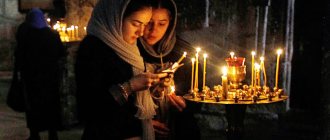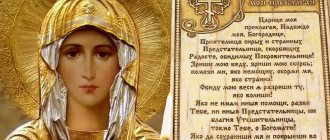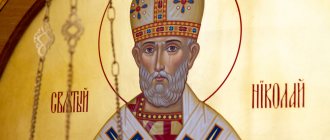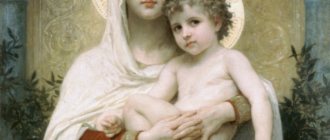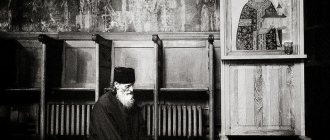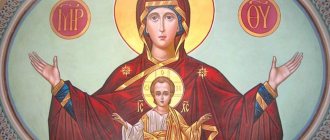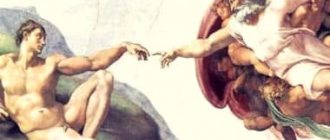Mother of God - Heavenly Intercessor
For an Orthodox Christian, prayer is living communication with God. She lifts a person above the vanity of life and lifts his requests and hopes to the Divine Throne. Prayer to the Mother of God gives a person hope.
“Just as the body needs food to live, so the soul needs to eat in order to live” (Paisiy Svyatogorets).
Orthodox Christians glorify the Lord in their prayers, call on the Angels and Heavenly powers, and ask the saints for help. And prayers to the Mother of God occupy a special place.
Icon of the Blessed Virgin Mary
She, who through deep humility and immaculate life became the Mother of Christ, became the spiritual Mother of all humanity. The words of Christ during His crucifixion on the Cross, addressed to the disciple John: “Behold, your Mother” (John 19:27), are addressed to every Orthodox Christian. Therefore, the Most Holy Virgin is the Intercessor and Intercessor for all people before Her Son.
Different Degrees of Our Participation in Church Services
Photo: Y. Kostygov / Expo.Pravoslavie.ru
Many people notice this important feature. At a service you don’t always stand as a full-fledged participant in the service. Sometimes you stand in the temple only as an observer of what is happening. Almost like an outside observer.
I would like to find out: how and when does an observer become a participant in liturgical prayers?
To avoid fruitless fantasizing on this important topic, we will try to reflect on the topics of temple prayers in line with the ascetic teachings that were developed by the holy fathers. In our Church there is such an ascetic teaching about thoughts.
Thoughts are not only sinful
It would seem that thoughts have nothing to do with it, because we are thinking about prayer. That's right. And the connection between prayer and thoughts can be traced in the ascetic writings: perfect prayer is prayer cleansed of sinful thoughts. And not only is prayer cleansed of sinful thoughts, but prayer is also cleansed of any extraneous thoughts. Stop! So, not all thoughts are necessarily sinful, bad? Not all. There are also thoughts that are essentially good, but only inappropriate during prayer, since they lead a person astray from the path of direct communication with God and interfere with prayer.
And in non-prayerful times, these same thoughts will, on the contrary, help and set a person up for spiritual actions, including prayer. That is, these thoughts are useful before prayer, but during prayer they are inappropriate.
This is what the holy ascetic Isaac the Syrian said about this kind of thoughts: “One elder wrote various sayings on the walls of his cell... and when they asked him: “What does this mean?”, he answered: “These are thoughts of truth coming to me from an Angel, abiding with me, and natural right thoughts arising in me; I write them down at the time of their appearance, so that, when I am darkened, I can deal with them and they will save me from delusion” [1]. That's what thoughts are.
Even the prayer itself, if it is short enough, could also be called a righteous thought. And the ascetic is called upon to cut off extraneous thoughts during prayer in order to preserve the prayerful thought: Lord Jesus Christ, have mercy on me.
From the ascetic experience of the fathers, we know that often sinful thoughts take root in the soul gradually: first the attachment of the thought, then a combination and conjunction with the thought occurs, then the struggle with the passionate thought flares up and captivity by it, then the thought acts almost unhindered in the soul.
In contrast to these stages of the rooting of passionate thoughts, let us consider in order those stages that a righteous prayer thought goes through before it takes root in a person’s soul during a temple service. So, a man comes to church for service...
The church prays and calls on the person who goes to church
The service began with a solemn exclamation: Blessed is our God!.. The priest turns to God with a prayerful blessing and calls on all those gathered to glorify God. Then other prayers are heard in the temple[2].
What's happening? The Church sows prayerful thoughts in a person’s soul—righteous thoughts. As in Christ’s parable about the sower: one seed falls on rocky soil, the other on fertile soil (see: Matt. 13: 3–8, 18–23).
“Let us pray to the Lord in peace,” is the direct appeal of the priest addressed to the people. What does the choir say? “Lord, have mercy,” this sounds like a saving prayer thought in two words. This is the Divine seed that the Church wants to plant in the soul of the person who comes.
The choir is called upon not just to beautifully sing “Lord, have mercy,” but to prayerfully sing these two words
The choir is called upon not just to beautifully sing “Lord, have mercy,” but to prayerfully sing these two words, responding to the call of the priest. The same applies to all of us. Will a person entering a church respond to the priest’s call: “Let us pray to the Lord in peace”? Not necessarily, the Lord does not force people to pray.
A person can behave differently. Let's assume that the person did not ignore the service that had begun. What's next?
Man heeds this church call
This does not yet mean that a person is praying - in the full sense of the word. He is only an attentive observer in the temple. He closely monitors how others pray, and follows with his mind. But not only with the mind. Prayer is also perceived by people on an emotional and aesthetic level. Coordinated, calm, everyday prayerful singing of the service can be pleasant for a person. This is not yet a spiritual pleasure, but purely musical, aesthetic, psychological (not only believers, but also some atheists sometimes like to stand in church and listen to the choir).
Even when a person in church does not pray himself, the prayers of others already influence him
So, a person stands in a temple and watches the service, but does not pray himself. But the prayer of other people already touches him in some way, influences him. Of course, this influence is not that deep.
But if a person himself takes a small but decisive step and responds with his prayer to someone else’s prayer, then he will ascend to the first step of the spiritual path and the influence of the church service on him will increase. From observation the person will move to participation in the service. But this is the next stage, let’s talk about it in more detail.
A man responds to a call to prayer
This response does not necessarily consist of a person singing along with the choir: “Heavenly King... come and dwell in us and cleanse us...”
Not necessary. The form may be different. In general, prayerful singing by all parishioners is relatively rare at services. In most churches, folk singing is provided two or three times during the entire long All-Night Vigil or Liturgy.
Meanwhile, the prayer response of people in the temple occurs much more often. Only it is expressed in other forms. Less noticeable than general singing.
Which ones? After singing: “Lord, have mercy,” the person begins a prayer movement with his hand and makes the sign of the cross. This is an ancient prayer gesture. It expresses our strong faith in the saving feat of the God-man Jesus Christ. With our sign of the cross we also participate in temple prayer, albeit silently.
Let me give you another example. After singing: “Lord, have mercy,” the man says one word to himself: “Have mercy...” One of his words is an echo of the prayer singing of the choir, which he heard, paid attention to it, and then added his short prayer to the general prayer.
Thus, a person has received a prayer thought from the choir (“Lord, have mercy”), and communicates with this saving prayer thought (“Have mercy”).
He is no longer an observer of worship. A person’s personal participation in a church service begins.
The struggle for more meaningful prayerful participation in the service
After a person begins to participate in the service, the struggle with extraneous thoughts flares up. It’s not so easy to get rid of them, to cut off these extraneous thoughts. It is not so easy to “cultivate”, to store prayerful thoughts, to let them live, “grow”, and gain strength in the space of our soul.
On the Cherubic Song, the Church calls on all of us: “Let us now put aside every care of this life. Let us raise everyone up like the Tsar.” We must first put aside all worldly cares and thoughts (even those that are appropriate at any other time) in order to serve God at the Liturgy - to raise and solemnly carry Christ the King on his shoulders - to the Throne of the Heavenly God.
Our prayer becomes God-bearing if we manage to put aside worldly thoughts and accept and keep the prayerful thoughts that the Church gives us during the service.
Putting aside worldly thoughts is not so easy for a person. For many years, through these worldly thoughts, sinful passions took root in his soul. The mind is constantly exposed to the pretexts of these sinful thoughts, the mind combines with them and converses with them.
These sinful thoughts make noise in the soul (in Slavic “rumour”) and violate the inner silence of the soul[3]. Sinful thoughts, like weeds, try to drown out prayerful thoughts.
At the stage of struggle with everyday worries, a kind of parity of forces is observed: a person fights against everyday thoughts with varying success. Sometimes a person at a service manages to accept and maintain a prayerful thought, but after some time his mind wanders to a distant country and is already occupied with everyday thoughts, that is, he loses his prayer. Then, having come to his senses, he again listens to the church service and participates in general prayer.
Prayerful thoughts take root
If the struggle against worldly thoughts turns out to be successful - with God’s help - then prayerful thoughts take root in the person’s soul. They become stronger than everyday thoughts, their voice sounds in full force, this saving voice cannot drown out the noise of everyday rumors. A person at a service prays “with heartfelt attention”[4].
A person is carried away by the general flow of prayer at a service; by listening to the sound of prayers and participating in the general church service, a person rushes to God.
Let us remember what exceptional aspiration the Church experiences during the Liturgy:
“We have sorrow in our hearts,” the priest calls.
“Imams to the Lord,” answers the choir.
“We thank the Lord,” sounds the Eucharistic prayer at the Throne.
In church, a person is not only carried away by the general flow of prayer. He not only perceives the general prayer aspiration, he actively participates in it. In other words, the person himself participating in the service also creates a common prayerful aspiration, to some extent [5].
Thus, a person not only “lights up” with common prayer, but also comes close to passing on this “flame of prayer” to others.
It is not at all necessary that this will result in direct spiritual guidance of other people. This can be a subtle, unostentatious influence on others, which is accomplished for the glory of God, although the person himself does not notice it, and does not at all consider himself a spiritual mentor.
Prayerful thoughts bear fruit
We briefly traced how the Church sows prayerful thoughts in a person’s soul, how a person listens to them, accepts them and responds to them, talks with them - talks with God, how prayerful thoughts take root, deeply touch a person, penetrate from the periphery of his life to the depths of his life. life, even penetrate into the very heart of his thoughts, feelings and aspirations.
And finally the moment comes when the prayerful thoughts sown in the temple and ingrained in a person bear fruit: some a hundredfold, others sixtyfold, and still others thirtyfold (see: Matt. 13:8). Prayer becomes life.
The liturgical miracle that happened in the church goes far beyond the church fence. It continues during non-liturgical times.
The person carefully carries the flame of prayer received in the temple home and lights the lamp with it. This is similar to how believers carry a light home from church on Maundy Thursday.
The grace of temple prayer supports a person’s prayerful attitude outside the temple, in his everyday affairs
The grace of temple prayer supports a person’s prayerful mood following the morning and evening prayer rules at home. The prayerful attitude manifests itself at any moment of the day, not only after waking up from sleep and before bed, before and after meals.
Prayerful thoughts are repeated many times a day, when performing any task, especially difficult and responsible: “Lord, help”; "Thank You, God." “Lord, forgive and bless,” a person asks when he realizes that he has acted badly.
Church prayer thoughts instilled in the heart nourish a person’s entire life in its most diverse aspects. They strengthen a person to repent and fight passions. And therefore prayer influences a person’s relationships with people. After all, our relationships often deteriorate due to the passions of anger, pride, condemnation, envy... Prayer changes a person’s attitude towards his responsibilities in the family, in school and at work.
Prayer transforms human life.
Prayer to the Mother of God
It is important to understand that one prayer to the Most Holy Theotokos does not guarantee the fulfillment of requests and desires. Prayer is not a magical conspiracy or a witchcraft formula, the reading of which promises inevitable success and well-being.
According to our sincere faith and pious life, the Mother of God intercedes for us before Her Most Pure Son. And the Lord Jesus Christ, fulfilling this commandment to honor parents (Ex. 20:5), hears and fulfills the prayers of His Mother. There is evidence of the great boldness (courage) of the Blessed Virgin before the Lord. For example, the first miracle of Christ at the wedding feast in Canna of Galilee. Then it was at the request of the Mother of God that water turned into wine (John 2:3-7).
Paisiy Svyatogorets explains this clearly and clearly.
“Suppose a woman’s neighbor is the mother of a minister, and the woman asks her to help her child find a job. The neighbor is ready to help, but she herself cannot do anything. And he will ask his son, the minister, who, by virtue of his position, can really help. And he will help because his mother asks. So we ask the Mother of God for our salvation, and She asks Her Son, Who can save. And He fulfills the Mother’s request because He loves Her very much.
The Mother of God transfers all our requests to Christ. But She herself, through Her care and tenderness, fills our souls with love for Christ” (A Word on Prayer. Volume VI).
How do prayers in front of the Tenderness icon help?
Since the time of the Saint’s life, it has been known that the icon has healing powers. If you pray sincerely, with deep faith, veneration of the Blessed Virgin and at the same time lead a Christian lifestyle, then it will definitely help.
At this great shrine, which was touched by the hands of God’s true chosen one, they ask for what it itself means:
- about getting rid of mental pain and suffering;
- about acquiring offspring;
- about the successful resolution of pregnancy.
Prayer before the Tenderness icon of the Most Holy Theotokos will give consolation to those who have lost their loved ones, because it was before her that one of the great saints of the Russian land, St. Seraphim of Sarov, left us. Therefore, we need to remember this possibility - you can change yourself and your life at any moment if you turn to our Holy Church with faith and hope. And she has words of consolation, recommendations and advice for everyone.
Prayer to the Mother of God
One of the simplest prayers to the Mother of God for help is the following: “Most Holy Theotokos, save us!” An Orthodox Christian should try to pronounce it as often as possible.
“On the third day, after Her blessed Dormition, the Mother of God rose from the dead and now lives in heaven, soul and body. She not only lives in heaven, She reigns in heaven... She has been given special power and special boldness to intercede before God on behalf of humanity. The Holy Church, turning with petitions to all the greatest saints of God, to all the Angels and Archangels, says to them: “Pray to God for us,” to one Mother of God she uses the words: “Save us” (St. Ignatius Brianchaninov).
Orthodox Life
Orthodoxy.fm
Churched people know what they can and cannot do in church. But for those readers who are experiencing difficulties, this material has been prepared.
For that part of our audience that is just embarking on the path of becoming acquainted with the Church, we are publishing 25 tips on the basic rules of conduct in church. They will help you to pray to God worthily, without being distracted yourself and without distracting other believers:
1. Men entering the temple must remove their headdress
The basis of this tradition is found in the Apostle Paul's 1st letter to the Corinthians, 11:4-5: “Every man who prays or prophesies with his head covered disgraces his own head.”
2. Women, on the contrary, must enter the church in a headdress
The tradition goes back to the same message. At the same time, the rule does not apply to girls and unmarried girls, because The apostle reports that the scarf is a sign of power over the wife of the husband - the head of the family. However, in modern practice, girls also often wear a headscarf when entering a temple, but they should not be forced to do so.
3. One of the main conditions of prayer is attentiveness. Worship in the temple also needs to be attended to, i.e. listen with concentration, participate in it with your mind and heart
Accordingly, during the service you should not walk around the temple a lot, kiss (kiss) all the icons in a row, look at people, talk with someone, make noise, talk on a mobile phone, eat food or drink drinks you brought with you, chew gum, change in pockets, etc.
4. Veneration of relics and icons
When venerating relics and icons, it is not customary to kiss the faces of the Mother of God, saints and angels, as well as the face of a saint whose relics are open for veneration (excluding the forehead - that is, the forehead).
5. When entering the temple, it is better to turn off your mobile phone completely or switch it to silent mode
It’s better to turn it off altogether because for an Orthodox person there is and cannot be anything more important than communication with God, and other matters can wait until the end of the service.
If you cannot turn off your phone (a relative is undergoing surgery or another particularly important occasion), then you should switch it to vibration mode so as not to distract others from prayer.
6. Video cameras, cameras and other technical devices
They are not prohibited, but their use (especially with a flash or flashlight) is allowed only with the blessing of the temple abbot. since it also greatly distracts believers.
7. You cannot enter the temple under the influence of alcohol or drugs.
You should not (except for special life circumstances) come to church unkempt, dirty or smelling bad. This is the place of our communication with God. One must have respect for Him and for the assembled believers.
Smoking in the Church is considered a sin (as deliberately causing harm to one’s own body), so it is worth abstaining from it, at least in the temple or on its territory.
8. Do not enter the Altar (the space enclosed by the wall of the iconostasis) or the Solea (the raised platform in front of the altar in the eastern part of the temple)
Only the clergy, clergymen singing in the church choir or helping the priest in the altar, as well as in special cases, with the blessing of the priest, are allowed to climb the solea. And only clergy and male clergy enter the altar.
9. During the service, stand facing the altar (iconostasis)
It is there that the central place of the temple is located - the Holy Throne, where the Eucharist is celebrated - the main Sacrament of the Orthodox Church, in which the true Body and true Blood of our Lord Jesus Christ is taught to the believer under the guise of bread and wine.
10. Don’t make comments or swear
The temple is not a place for quarrels, it is a place for prayer. If someone in the temple looks inappropriate or does something we don’t like, it’s better to turn our attention to prayer. As a rule, in each temple there are special people who have received the blessing of the priest to keep order there. As a last resort, you should approach and, politely and quietly, make a remark.
11. They wear their best to church
They go to a meeting with God as if they were going to a holiday, dressing in the best clothes. At the same time, avoid “flashy” colors that irritate the eyes of others.
Women dress like women in church: skirts to the knees or below, covered shoulders, back and chest area. Trousers are undesirable, as is an abundance of cosmetics.
Men should dress like men: preferably in a classic suit or trousers and a shirt. You should not come in T-shirts, shorts, or tracksuits.
12. You are not allowed to enter the temple with bicycles or animals.
The temple is not a garage or a stable, but a sacred place. Bicycles are not allowed into the temple. Decorative dogs, cats, rats and other animals should also be left at home when going to church.
13. Buy and donate candles before or after the service.
By doing this, you will not distract those praying. It is also better to consecrate crosses and medallions not during the service, but before or after.
14. Church records list the names of Orthodox Christians
You should not write in the note the names of people of other faiths, unbaptized people and suicides. When indicating the names of relatives, write the person's full name given at baptism.
There is no need to indicate a variety of titles before the name. The Lord himself knows who is in what position and circumstances and gives the person appropriate help.
Traditionally, only before the name of the clergyman the note indicates the holy rank: “patr.”, “archbishop”, “abbot”, “priest”, “deacon”, “mon.” and so on.
15. Children in the temple must behave decently
When going to church with children, you need to explain to them (if, of course, they are already able to understand human speech) that there is no need to talk loudly in church, run, laugh and stomp, or throw tantrums. If children do not know how to behave in church, it is better not to take them to the service.
16. A person participates in prayer with his whole being
Both soul and body. Therefore, in the temple it is customary to mostly stand - this is uncomfortable and naturally attracts our attention, as well as cross ourselves and bow. Sick people, children, or during some brief moments of the service can sit in the church.
17. During the Sacrament of Confession (Repentance), sins are confessed
Your sins. Do not tell the priest the sins committed by another person; this is a matter of his conscience. Also, do not name all your sins in a row; repentance requires awareness of what you have done and a desire to change. If you have not committed any sin since your last confession, you should not mention it next time.
18. The Sacrament of Confession should not be confused with pastoral conversation
When coming to confession, a person should repent of his sins, and not talk about all the accumulated troubles and problems. Usually, one priest takes confession from several dozen people. Therefore, out of love for other believers, you should not linger too long at the lectern (the stand on which the Cross and the Gospel lie).
If you need pastoral or life advice from a priest, it is better to arrange a conversation with him during non-liturgical times and then, without rushing anywhere and without delaying anyone, resolve all issues with him.
19. When approaching the Holy Chalice and receiving Communion, you should loudly say your baptismal name
In this case, the hands should be folded crosswise on the chest (the palm of each is on the opposite shoulder, the right one on top of the left), and the mouth should be opened wide so that the priest does not accidentally drop the shrine. The Communion must be swallowed immediately, then kiss the edge of the Chalice and go to the drinking table (behind everyone).
Only after you drink the shrine, you can talk and venerate the icons (so that particles of the Body and Blood of Christ do not remain on objects and do not accidentally fall to the floor).
20. When giving communion to children, they need to be held correctly.
Under no circumstances should a child knock over the Holy Chalice or push away the priest’s hand! The communion should not end up on the floor or clothes! Therefore, when bringing the baby to the Chalice, you need to securely hold the child’s arms and legs so that he cannot dangle them. It’s better to put it on your right hand and hold the arms with it, and grab the baby’s legs with your left.
The child must be gradually accustomed to the Sacraments. If he bursts into tears or gets scared, that's normal. You need to step aside for a while or go outside and calm him down.
21. Prayers after the Creed and before the end of Communion are the most important in worship
At this time, the main Sacrament is performed in the altar - bread and wine are mysteriously transformed into the Body and Blood of Christ. This is not an intermission in the theater.
At this time (it is called Eucharistic prayers) there is no need to start walking around the church, talking with others, going out into the street, sitting down, buying candles, etc.
22. In most churches, women stand on the left half of the temple, and men on the right
This is also done so as not to distract each other from prayer.
23. When a bishop or priest blesses those praying, bow their heads
A bishop or priest can incense believers, sign them with a cross, candles (bishop) or bless them with his hand. At these moments of worship, believers bow towards the priest.
24. Alms are usually given in food or clothing.
You can often find beggars near the temple asking for help. Helping those in need is a pious duty of a Christian, but many are embarrassed, fearing that beggars will use their donations to buy alcohol for themselves or that bandits will take it away from them.
In order not to unwittingly judge those in need and not leave them without help, it is better to give them alms in kind - buy and give them a loaf of bread, a carton of milk, a chocolate bar, give them a set of groceries or bring them clean clothes as a gift. If a person asks for money for a ticket and you can afford it, buy him a ticket.
If you don't have money, a kind word can be a charity. Sympathy can also be very important, do not forget about this.
25. Don't be afraid to be embarrassed
It is not for nothing that believers call each other “brothers and sisters.” If you don’t know what to do correctly in a particular case, ask a priest or a more experienced Christian for advice.
Andrey Szegeda
Song to the Mother of God
Among the ancient prayers to the Blessed Virgin is the prayer “Virgin Mother of God, Rejoice!” It dates back to apostolic times and is woven from the words of Holy Scripture. Thus, the first part of the prayer is the appeal of the Archangel Gabriel to Mary when he announced her conception of Jesus Christ (Luke 1:28).
The words “Blessed are You among women, and blessed is the fruit of Your womb!” belong to the righteous Elizabeth, who, filled with the Holy Spirit, offered praise to the Mother and Her Child (Luke 1:42). We can consider that this was the first prayer to the Mother of God.
“Virgin Mother of God, Rejoice, O Blessed Mary, the Lord is with Thee, blessed art Thou among women, and blessed is the fruit of Thy womb, for Thou hast given birth to the Savior of our souls.”
History of the icon
There are several images of “Tenderness,” but the one in which the Blessed Virgin is depicted alone, with her eyes downcast and her arms crossed on her chest, stands out for its history. This image is full of strong feelings, because it refers to that period of her life when Archangel Gabriel had already announced to the Virgin Mary that she had been chosen to give birth to the Savior. She knows about this, she is confident in the future miracle, and feelings overwhelm her innocent soul. It is the words of the Archangel that are written on the halo of this image: “Rejoice, Unbridled Bride.”
And the feeling of humility, spiritual participation, quiet joy, which are depicted on the icon, was expressed by the Virgin Mary in the words: “Behold, the servant of the Lord; let it be done to me according to your word.”
According to legend, the icon belonged to Seraphim of Sarov, who found it and hung it in his cell. The presence of this wonderful image in the modest cell of the Holy Hermit became known in 1815, when he began to receive petitioners. He anointed the sick who came to him with oil from a lamp in front of this icon, and thereby healed them.
Saint Seraphim called her “Joy of All Joys” - which is very suitable for the surprisingly tender image of the Mother of God.
It was in front of this icon that the saint died, kneeling and praying the prayer “Tenderness” to the Most Holy Theotokos. This happened on January 2, 1833. That is, Seraphim of Sarov had the icon for at least 18 years.
After the death of the saint, it was transferred to the Sarov Monastery, to which Seraphim belonged, but Abbot Nifont handed it over to the sisters of the Diveyevo Seraphim Monastery, whose spiritual mentor was the deceased elder and whose charter was used in this monastery.
After the revolution, the monastery existed for some time, but in 1927 it was closed and partially destroyed. The Tenderness Icon was kept as a great shrine that belonged to the deceased saint. And in 1990, she was placed in the newly consecrated boundary in her honor.
Since then, pilgrims again began to read prayers to the Mother of God in front of the Tenderness icon, which acquired the addition of Seraphim-Diveevskaya.
The icon of Seraphim of Sarov is now in Moscow, in the Patriarchal residence. In the Diveyevo Monastery there is a list of it, which also has healing powers. But once a year the shrine always comes to its monastery for celebration.
Song of praise to the Mother of God
The so-called Song of Praise to the Mother of God occupies an important place.
“It is worthy to eat, as you are truly blessed, the Mother of God, the Ever-Blessed and Most Immaculate and the Mother of our God. We magnify You, the most honorable Cherub and the most glorious without comparison Seraphim, who gave birth to God the Word without corruption.”
This prayer is also called the Archangel's Song. This is connected with the legend that at the end of the 10th century the Archangel Gabriel himself “suggested” this doxology of the Most Holy Theotokos.
An unfamiliar young man knocked on the door of one monk’s cell on Mount Athos. When they began to pray with the words known to the monk, “The most honorable Cherub...”, the guest said: “We glorify the Mother of God differently!” and uttered the words of the Song of Praise that are known today. During this doxology, the icon of the Mother of God, in front of which they prayed, shone with an unearthly light. The monk asked the young man to write him this text. There was no paper in the cell. Then the unusual guest inscribed it with his finger on the stone, which at that moment became soft, like paper. Introducing himself by the name Gabriel, the young man disappeared. Then the monks realized that the miraculous visitor was Archangel Gabriel himself.
Prayers before the icons of the Blessed Virgin Mary
“Let our believing heart, knowing the great power of the intercession of the Mother of God, always fall at the feet of the Mother of God with its sighs, needs, sorrows, in all trials and in moments of crying over sins. And She, the Joy of all who mourn, our Heavenly Mother, extending Her sovereign Protection, will intercede and save and have mercy on us all” (Archimandrite John Krestyankin).
Honoring and pleasing (glorifying) the Mother of God, Orthodox Christians treat the icons of the Most Holy Theotokos with special reverence and love. Today there are about seven hundred of Her revered images. There are many stories of miracles from prayers in front of these icons.
One of the most revered in Rus' is the icon of the Mother of God of Vladimir. According to legend, her image was painted by the Evangelist Luke himself. Repeatedly this icon helped the Russian people achieve victory over foreign conquerors.
The Vladimir Icon of the Mother of God came to Rus' in the 12th century from Constantinople. Then the image was given as a gift to Prince Yuri Dolgoruky. While in the city of Vladimir with the icon, his son, Prince Andrei Bogolyubsky, encountered a miracle. The harnessed horses stood up and could not go further. Then the prince realized that the will of the Blessed Virgin was to stay here in Vladimir. A temple was erected here in honor of the Most Holy Theotokos, where the miraculous image was placed.
Through the Vladimir Icon, the Mother of God showed many miracles. She helped Andrei Bogolyubsky defeat the Volga Bulgarians. Saved Moscow from the invasion of Khan Tamerlane. She protected Khan Akhmat from the troops of the Golden Horde. She saved Makhmet-Gireev from ruin by the Khan of Kazan... Before the image of the Vladimir Icon of the Mother of God, Orthodox Christians prayed and continue to pray in all their problems and difficult issues.
Prayer in the temple
Hello, dear children and parents!
Through their prayer the place where they were gathered was shaken. (Acts 4:3)
A Christian should pray always and wherever he is. Immediately after waking up, before starting any task, before eating and after, going to bed, in all difficult circumstances, always when we want to thank God. In addition to personal prayer, every Christian should take all possible participation in church prayer when visiting a church.
Prayer in the temple
The temple of God is the earthly sky. Here we gather for common prayer. The Lord said that if two or three are gathered in His name, then the Lord himself is in the midst of them and will fulfill what is asked.
Obviously, all healthy Christians should attend church services whenever possible. And especially try not to miss festive all-night vigils and liturgies.
The Monk Barsanuphius of Optina believed that a sure sign of the death of the soul is avoidance of church services.
Sometimes it happens that standing in the service is difficult, it is hot, stuffy, and the long service tires the body. But those who have experience have long noticed that uncomplaining, grateful patience, even for something small for the sake of participation in the service, is always rewarded. After the Divine service, a Christian is always spiritually filled, in a state of spiritual joy and vigor. This makes you forget and you don’t feel bodily fatigue.
Food dulls the heart for prayer
The Holy Fathers strongly advise not to eat food before attending the Liturgy. The holy righteous John of Kronstadt wrote that a full stomach becomes an unnecessary and harmful burden that drowns the heart for prayer. It can be difficult to acquire holy thoughts and feelings. It is extremely necessary to be careful not to eat before the Divine service. “The Kingdom of God is not food and drink” (Rom. 14:17). God cannot reign in a heart weighed down by overeating and drinking.
But for the sick and elderly there are mitigations of the above recommendation. Those who, due to bodily weakness, can become weak due to prolonged strain on the body from standing in the temple, can have relief.
There is nothing higher, more majestic and more life-giving than the Liturgy. The priests symbolize Christ Himself, Angels, Cherubim, Seraphim and Apostles. As Prv writes. John of Kronstadt, “The Liturgy is a constantly repeating triumph of God’s love for the human race and an omnipotent intercession for the salvation of the whole world and each person individually.” After such words, how can one not rush to visit God’s temple and pray collectively during the Divine service?
Temple prayer

